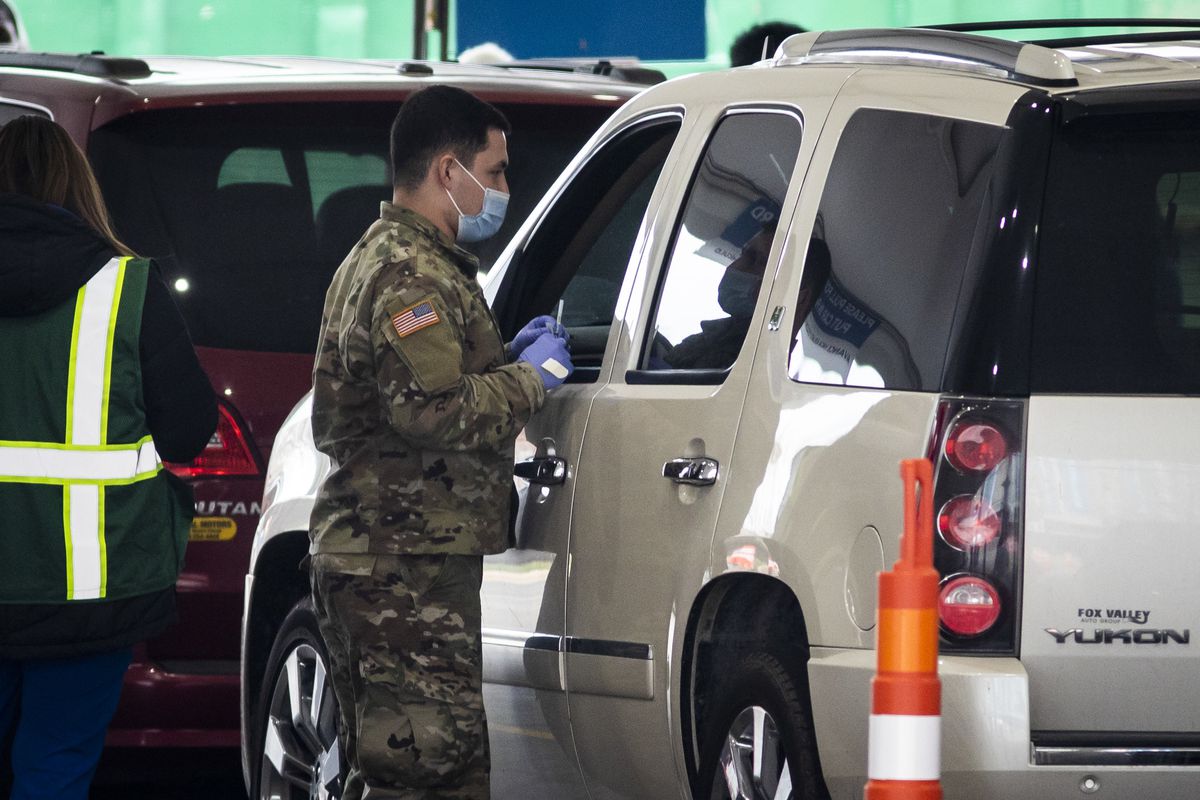The latest
Illinois’ coronavirus positivity rate remains at a two-month high
Illinois’ coronavirus positivity rate remained at a two-month high Sunday, continuing a troubling upward trend that could lead officials to tighten restrictions on businesses once again.
State health officials reported 2,449 new and probable COVID-19 cases that were detected among 64,116 tests processed in the last day. That kept the state’s seven-day positivity rate for a second day at 3.8%, the highest it’s been since Feb. 2.
In March, that figure, which experts use to gauge how rapidly the virus is spreading, dropped to the lowest since summer. In fact, the state’s seven-day positivity rate remained below 3% for nearly six weeks, from Feb. 15 to March 27.
Over the last week, though, that figure has been on a gradual rise.
While the state’s overall positivity rate remains well below the peak levels seen last fall, suburban Cook County and Chicago’s test positivity rates have climbed steadily and are creeping toward the 8% benchmark that could result in a scaling back of recently expanded indoor business capacity limits.
The Chicagoland area’s databases aren’t updated on weekends. But as of Friday, both suburban Cook County and Chicago had a test positivity rate of 5%. For Chicago, that’s up more than a full percentage point from the previous week, when that figure checked in at 3.7% March 26.
Officials warned Saturday that tighter coronavirus restrictions could soon be in store for businesses in suburban Cook County if this upward trend continues.
“We may very well have to clamp down within a matter of days,” said Dr. Rachel Rubin, co-lead and senior medical officer for the Cook County Department of Public Health, who partially blamed the uptick on COVID fatigue. “I’m not promising that one way or the other. We need to evaluate exactly what kinds of activities and movements do we think are really pushing this surge.”
Read the full story from Madeline Kenney here.
News
9:05 a.m. Deep dish in depth: Patrons sample pizzas and hear their stories on new walking tour
With summer on the horizon and some recent easing of restrictions on indoor/outdoor dining, pizza lovers can now partake of their favorite food in a whole new dining experience.
Finger Licking Foodie Tours is debuting its self-guided Chicago deep-dish pizza walking tour starting Monday (which also happens to be National Deep-Dish Pizza Day). The brainchild of Chicago-born entrepreneur Donald Contursi, the tour is born of his hugely successful Las Vegas foodie tours, which expose patrons to four three-course dinners at some of Sin City’s most acclaimed restaurants.
But like the Vegas incarnation (Lip Smacking Foodie Tours), the Chicago version — a self-guided endeavor (until pandemic restrictions allow for larger groups and an in-person tour guide) — is more than just food. It’s the chance to spend some quality time with friends and/or family (minimum two people per tour) for an afternoon or evening trek, and it’s about the stories behind some of the city’s most iconic deep-dish pizzas and the pizzamakers.
The two-hour tour (available every day, every half hour) includes stops at three restaurants without the long wait; because it’s a prepaid tour, guests will be seated upon arrival and served within 10 minutes. Each tour stop allows for 35 to 40 minutes to enjoy a small, deep-dish half cheese/half sausage pizza for two (vegetarian versions also available). Drink packages are also available at additional cost. And not to worry, you can take any leftovers with you as you head to the next eatery to sample another pie (a map and voice-over guide on your cell phone will direct you step-by-step to the next location).
Read the full story from Miram Di Nunzio here.
New cases and vaccination numbers
- State health officials reported 2,449 new and probable COVID-19 cases that were detected among 64,116 tests processed in the last day.
- As of Friday, both suburban Cook County and Chicago had a test positivity rate of 5%.
- As of Saturday night, 1,491 beds were occupied by COVID-19 patients. Of those, 336 were in intensive care units and 143 were on ventilators.
- In total, Illinois has administered 6,290,822 vaccine doses since December, including 102,215 on Saturday.
Analysis and commentary
10:41 a.m. Chicago, let’s get back on the L and do our part to save public transit
Get on the L or a bus. Or both.
This avid CTA rider has been tripping around town on trains and buses throughout the past year and, yes, during the reign of COVID-19. My elderly mother does her regular shopping via the CTA. My nephew rides the L to his job on the graveyard shift. We are all safe and sound.
When I tell friends, jaws drop. “You take the CTA?” Then I tell them to get on board. Chicago needs our butts in those seats.
I gave up my driver’s license 25 years ago. Public transportation is infinitely cheaper and wiser than driving. I am a proud CTA cheerleader. We have been blessed with one of the best transit systems in the nation. Now, it is in peril.
My fellow public transit riders have abandoned my beloved CTA. The empty seats and aisles tell the tale. The system suffered a 57% decline in ridership last year, as the Chicago Reader reported last month.
I get it. During the pandemic, riders have shunned public transportation. Some fear COVID-19. Others are working from home. Many are jobless. We all have heard the tales of decline. Stories about filth, vagrancy, harassment and worse on the CTA.
Thankfully, Mayor Lori Lightfoot and transit officials have avoided service cuts and layoffs. An influx of more than $817 million in federal stimulus funds have kept the CTA rolling.
Now as the pandemic eases, riders are beginning to return. But the CTA still posts fewer than 500,000 average daily rides, compared with 1.5 million before the pandemic, according to the Reader.
We are desperate to return to normal. When we do, we must do it via the CTA. If riders don’t return to the CTA, Metra and Pace, look for layoffs, service cuts and hefty fare hikes. That would be devastating, especially to the essential workers and working-class families who have no other transit options.



















